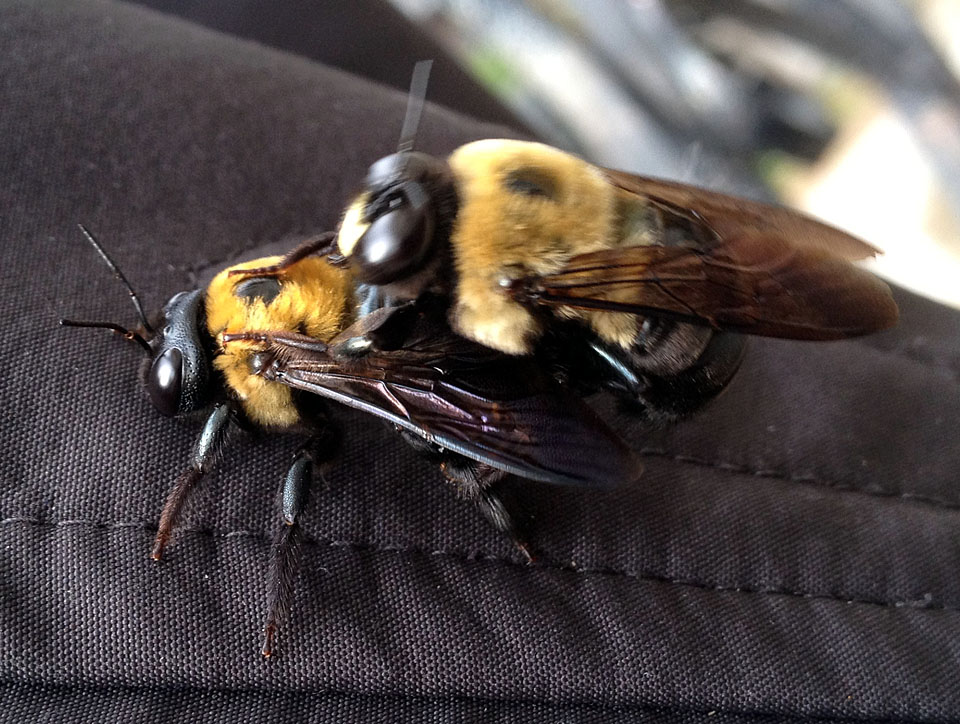

More InformationĬarpenter bees are important pollinators and are very useful in providing this beneficial service to agriculture, plant growers and fruit producers. Large carpenter bees have one generation per year in the northern states, but in southern states like Florida, they may have two or more generations per year.Ī particularly interesting characteristic of a few species of Ceratina is they can reproduce without males, a trait known as parthenogenicity. They mate, feed on pollen and nectar, return to their gallery to overwinter and then emerge the following spring. Newly developed adults usually remain in their galleries for several weeks and leave their brood cells in April or May. It takes about seven weeks for a carpenter bee to reach adulthood, but developmental time may vary depending on temperate or other environmental conditions. Lifecycle & ReproductionĬarpenter bees have four life stages: egg, larval, pupal, and adult states. The small bees also provision their brood cells with pollen and nectar. Females overwinter as adults in partially or completely excavated stems, and in the spring, the female bee further excavates and creates a brood nest much the same as large bees. Small carpenter bees, or Ceratina, generally excavate twigs and stems to build their nests. The eggs hatch and become larvae that feed on the food ball until they pupate. When finished, she places a food ball (made from pollen and regurgitated nectar) inside a brood cell, lays an egg, and blocks the chamber off with chewed wood pulp. The female then partitions off brood cells into linear rows. The bore hole goes into the wood perpendicular to the wood's grain for about 1-2 inches and then takes a right angle turn continuing as an excavated gallery (tunnel) that runs about 4-8 inches. This hole is slightly less than 1/2-inch wide, which is about the diameter of her body and looks much like a carpenter used a 1/2-inch drill to create the opening. When required, females will use their strong mouthparts to chew round nest entrances in flat wood surfaces. Refurbished tunnels may increase several feet over several years. As a result, females often prefer to inhabit existing nests instead of excavating new ones. Gallery construction is a labor-intensive process that takes a lot of time and energy. The bees sometimes bore into painted wood, especially if the paint covering is old and weathered. They prefer pine, fir, cyprus, oak and redwood, especially if the wood is not covered with bark, is unpainted or unfinished. One of their favorite items to excavate is the rails and posts of oak split rail fences. Large carpenter bees excavate dry, unpainted and weathered wooden objects such as the following: Some kind of yellow markings on the body and face.Ĭarpenter bees do not eat wood but do feed on plant pollen and nectar. No visible hairs on the top of the abdomen Yellowish hairs on the legs, thorax, and abdomen (not as as vibrant or as numerous as they are on bumble bees) Similar in size and appearance to bumble beesīlack, greenish black, metallic blue, or purplish blue in color The most obvious characteristic used to separate large and small bees is size. Xylocopa is the group of most likely to make their presence and associated damage known to property owners. Within the United States carpenter bees are categorized in two genera – large carpenter bees ( Xylocopa) and small carpenter bees ( Ceratina). Also, your PMP may recommend sealing existing bore holes to discourage bees that are searching for possible nesting sites.

Your PMP will also inspect for weathering that will make it likely that the bees will attack. A control technique that does not use insecticides is to paint any bare, exposed wood surfaces that are being attacked with exterior paint or a polyurethane finish. While only a temporarily effective method, applying a liquid insecticide to the wood surface is a less time consuming process than applying dust to drill holes.
#CARPENTER BEE FREE#
Sometimes it may also be useful to apply an aerosol spray to control free flying carpenter bees. Once the bees die, the drill holes can be sealed and repainted. The most effective control method is to apply an insecticide dust to the bee's drill holes and leave the holes open for a few days so returning bees will contact the insecticide. Once the inspection is complete, the pest control plan is prepared.
#CARPENTER BEE PRO#
During the inspection, your Pro will inspect to accurately identify the offending pest and locate any damage.
#CARPENTER BEE PROFESSIONAL#
Carpenter bee prevention and treatment begins with a thorough inspection performed by your pest management professional (PMP).


 0 kommentar(er)
0 kommentar(er)
